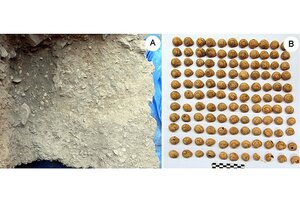Paleo-escargot? Humans living 30,000 years ago dined on snails, say archaeologists.
Burnt snail shells at an archeological site in Spain suggests that paleolithic people on the Iberian Peninsula harvested and ate the mollusks, say scientists.

Archaeologists recently uncovered evidence of (a)a fireplace and (b) snail shells with evidence of burning in a rock shelter in Spain. The find, which dates to 30,000 years ago, suggests humans ate snails during the Paleolithic period.
Fernández-López de Pablo et al.
Escargot is more than just a modern delicacy: Ancient humans who lived 30,000 years ago ate the mollusks too, a new archaeological excavation has revealed.
Hundreds of burnt snail shells were found near fireplaces along with tools and other animal remains in rock shelters along a cliff in Spain. The finding suggests Paleolithic people on the Iberian Peninsula ate snails more than 10,000 years earlier than those who lived in the neighboring Mediterranean region.
The snails probably didn't make up a calorically significant part of these Paleolithic people's diet, but may have provided key vitamins and nutrients, said study lead author Javier Fernández-López de Pablo, an archaeologist at the Institut Català de Paleoecologia Humana i Evolució Social in Spain. [The Top 10 Mysteries of the First Humans]
Snail's pace
Neanderthals may have munched on sea slugs, but there isn't much evidence that modern humans ate land-based snails until about 20,000 years ago, Fernández said.
"Even though land snails are very present in paleolithic sites, the interpretation of snails as a food resource is very complicated," Fernández told Live Science.
For one, snails live in the dirt, so it's conceivable they accumulated naturally after dying there. And other predators that eat the mollusks, such as hedgehogs or birds, could also have left snail shells behind after eating the shells' occupants, Fernández said.
Paleo appetizer
Fernández and his colleagues were excavating a site in Benidorm, Spain, about three years ago when they came upon signs of ancient inhabitants. The site, called Cova de la Barriada, contained ancient fireplaces, stone tools, animal bones — and hundreds of snail shells close to the evidence of ancient cooking. The other animal bones found at the site appeared to have been intentionally fractured by people to extract the marrow, Fernández said.
The snail shells were burnt and all came from the same species, Iberus alonensis, which even today is a delicacy often found in Spanish dishes like paella, Fernández said.
The snail shells were also found along with charcoals of pine and juniper. In addition, the snails were all about the same size, indicating they were harvested when they were fully grown, at about 1 year old.
Together, the findings suggest the ancient inhabitants of the region ate the snails as a regular part of the diet. Snails are rich sources of vitamins A, B3, B6 and B12, and also provide a hearty helping of cholesterol, he said.
By harvesting only adults, the ancient people had developed a "sustainable" farming practice that, based on the size of snail shells found in multiple geologic layers, lasted for 4,000 years, Fernández said.
It's not clear why people were eating snails at this time and not earlier, but human cultures were going through a transition at this point, with the emergence of new artistic expression in cave paintings and living in larger settlements. So it's possible that society was also changing in ways that enabled them to use dietary resources in their environment more effectively, Fernández said.
Follow Tia Ghose on Twitter and Google+. Follow Live Science @livescience, Facebook & Google+. Original article on Live Science.
- Image Gallery: Our Closest Human Ancestor
- Amazing Mollusks: Images of Strange & Slimy Snails
- 8 Grisly Archaeological Discoveries
Copyright 2014 LiveScience, a TechMediaNetwork company. All rights reserved. This material may not be published, broadcast, rewritten or redistributed.

